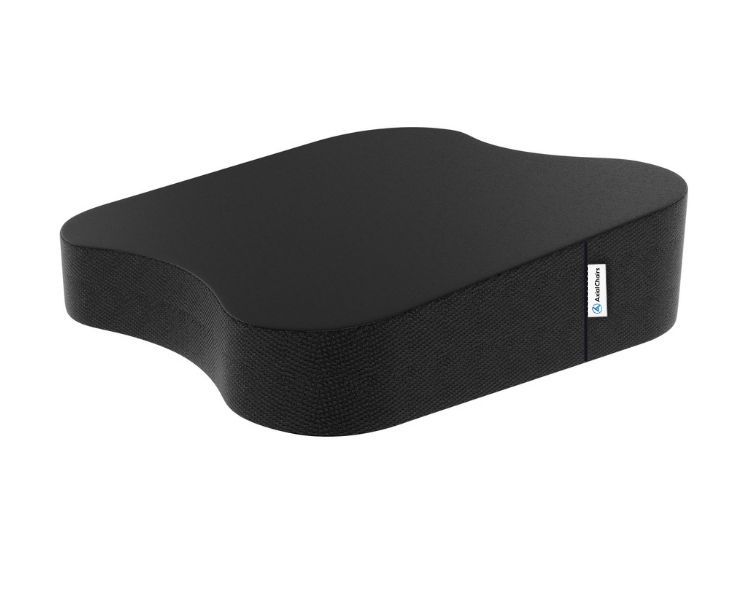Do you ever feel a pinch in your neck, even when sitting perfectly still? Does it come and go throughout the day, not seemingly related to any specific activity or position? If so, you are certainly not alone. Many people experience neck pain while sitting as a result of poor posture, muscle tension caused by stress/anxiety/depression, increased use of technology such as phones and laptops, or even sleeping in an awkward position. Understanding why your neck hurts while sitting is essential for knowing how to address this underlying issue and relieve that pinch in your neck once more. Join us today to learn about potential causes for your discomfort—and helpful ways to begin feeling better soon!
As a general rule, neck pain while sitting is a common problem caused by poor posture, which can be relieved by using an ergonomic seat cushion. A natural latex ergonomic seat cushion with an 8 to 11 degree forward tilt promote proper spinal alignment, reducing pressure on the neck and upper back muscles.
Neck pain is a common issue that affects many office workers. As someone who has been practicing chiropractic for over three decades and also trained as an ergonomist, I have the knowledge and experience needed to help alleviate this problem. I have written a book on posture, appeared on national TV to discuss this topic, and developed products to help people improve their posture and comfort while sitting. I even successfully crowdfunded a project to create a set of ergonomic seat cushions. I am confident that I can steer you into the right direction.
Top 5 Tips for Neck Pain While Seated
First, let’s put on our detective hats and investigate the possible reasons for that pesky neck pain. From my clinical experience, the most common culprit is poor posture, which leads to spinal misalignment and, ultimately, neck pain. But don’t worry! I have some tips and tricks up my sleeve to help you sit comfortably and pain-free.
The secret sauce to maintaining a pain-free neck while sitting is spinal alignment and a balanced, strong core. When your spine is properly aligned and your core muscles are engaged, your body is better equipped to distribute the weight and pressure evenly. This reduces the strain on your neck and helps prevent pain.
Now, you may be wondering, “How do I achieve this magical spinal alignment and a strong core?” I’ve got you covered!
Adjust your workstation: Make sure your computer monitor is at eye level, so you don’t have to strain your neck looking up or down. Keep your shoulders relaxed, and your elbows bent at a 90-degree angle.
Sit up straight: Engage your core muscles by sitting tall with your chest lifted and your shoulders pulled back. This helps maintain a natural curve in your lower back and keeps your spine aligned.
Take breaks: Sitting for long periods can cause your muscles to become stiff and fatigued. Stand up, stretch, and move around every 20-30 minutes.
Strengthen your core: Incorporate core-strengthening exercises, such as planks and bridges, into your workout routine. A strong core provides better support for your spine and reduces the likelihood of neck pain.
Choose the right seat cushion: I always advise using an expert-designed ergonomic seat cushion made with a natural latex top and a high-density base layer foam. These materials offer excellent pressure support and resilience, ensuring that you’re sitting comfortably for extended periods.
All Day Comfort & Support
I explain the concept of my ergonomic design on a TV show HERE
Why not memory foam? Although memory foam may seem like a popular choice, I do not recommend it. Memory foam lacks pressure support and resilience, and it’s a toxic material that gets hot when you sit on it for long periods. Natural latex and high-density foam provide a much healthier and more comfortable alternative.
Fashioning an Ergonomic Chair: Tips and Approaches
To effectively manage your seating needs, it’s essential to emphasize various aspects, with chair customization being a vital element. Numerous methods can be applied to accomplish this, such as incorporating a purpose-built seat cushion and lumbar support. These additions can mitigate pressure on your back and legs, enhancing comfort and maintaining good posture during extended sitting sessions. Also, ensure your feet are flat on the floor and that there’s sufficient clearance between your chair and work area. By implementing these suggestions, any typical firm chair can be upgraded into an ergonomic sanctuary that nurtures long-lasting health and well-being.
Ergonomic Seating Enhancement
An ergonomic seat wedge (displayed above) can be used to properly align your spine and promote balance. This exceptional natural latex cushion helps strengthen core muscles while relieving strain in other regions, such as the neck and shoulders. Additionally, sitting upright is less strenuous on your hips and knees, as it involves more muscle groups at once compared to reclining on a soft surface. This vertical posture helps ward off strain-inducing habits that individuals may unwittingly adopt while working.
Best Seat Cushion for Spinal AlignmentAxial Ergonomic Seat Cushion® | Seat Chair Wedge
Quick Guide: A 30-Second Summary

All Day Comfort & Support
Product Name
Axial Designs™ Seat Cushion
Price
$149
Warranty
1 Year
Type
Posture Wedge
Top Layer
100% Natural Latex (Molded)
Bottom Layer
High-Density Foam
Top Material
Isometric Grippy Vegan Leather
Bottom Material
Non-Slip Material
Side Material
3D Breathable Fabric
Neck Pain When Sitting up Straight: Understanding the Importance of Good Posture and Pain Prevention Techniques at Home and in the Clinic
I know how you feel – neck pain can be a real nuisance when you’re just trying to sit up straight. In my clinical experience, maintaining proper spinal alignment and a balanced, strong core is crucial for preventing neck pain while sitting. At home and in the clinic, I advise patients to focus on maintaining good posture by engaging their core muscles and keeping their head in a neutral position. Using an expert-designed ergonomic seat cushion made with a natural latex top and a high-density base layer foam can provide additional support and comfort.
How to Relieve Neck Pain When You Sit at a Desk: Effective Pain Management Strategies and Treatment Options to Reduce Discomfort and Improve Productivity
I’ve written a complete hands-on review about the best sitting position for sciatica, and here is what I tested best with my sciatica patients.
Sitting at a desk for long periods can lead to neck pain, but I’ve found that several pain management strategies can help alleviate discomfort. These include taking regular breaks, stretching, and practicing relaxation techniques. Additionally, I recommend using a high-quality ergonomic chair and making sure your computer monitor is at eye level. In some cases, it may be beneficial to seek professional treatment, such as chiropractic adjustments, massage, or physical therapy.
Neck and Shoulder Pain When Sitting: Causes, Symptoms, and Solutions for Tension and Strain Related to Poor Sitting Habits and Posture
Poor sitting habits and posture are often the culprits behind neck and shoulder pain. Slouching, hunching over, and craning your neck can put undue stress on your muscles and spine. To counteract this, I encourage my patients to focus on maintaining proper spinal alignment, sitting with their feet flat on the floor, and using a supportive ergonomic chair. Strengthening core muscles and incorporating regular stretching and exercise can also help prevent tension and strain.
Neck Pain While Sitting on Couch
Identifying Common Triggers and Traps to Prevent Pain and Finding Relief Through Self-Care and Professional Treatment
Sitting on the couch may seem relaxing, but it can contribute to neck pain if you’re not careful. Common triggers include slumping, using unsupportive pillows, and sitting in awkward positions. To alleviate pain, I recommend sitting with proper posture, using supportive cushions, and taking breaks to stretch and move. If neck pain persists, consider seeking professional treatment from a chiropractor or other healthcare provider.
All Day Comfort & Support
Neck and Shoulder Pain From Sitting at Computer
Examining the Impact of Poor Posture and Navigating Strategies for Successful and Sustainable Pain Treatment and Management
Our reliance on technology has led to an increase in neck and shoulder pain related to computer use. In my clinical experience, I’ve found that implementing ergonomic workstations, taking regular breaks, and practicing good posture can help mitigate these issues. Additionally, staying active and maintaining a strong core can help support spinal alignment and reduce the risk of pain. If neck and shoulder pain becomes chronic or severe, seeking professional treatment, such as chiropractic care or physical therapy, can provide long-lasting relief.
Final Thoughts
While it is possible to be completely symptom free with many medical conditions, including neck pain while sitting, the best thing you can do for yourself is to pay attention to your body and take steps to relieve your symptoms. Pain is not something anyone should ignore or just accept. Seek medical advice from a qualified health professional if your neck pain persists for more than two weeks. They can help diagnose the cause of your pain and provide relief and therapy options that may work best for you.
Additionally, learning safe posture practices, doing gentle exercises or stretches at home, and investing in ergonomic office furniture are all great ways to prevent future neck pain while sitting. Remember: you have the power to make decisions that will improve not only your physical health but also your mental wellbeing. Make sure you take time out of each day to actively check in with your body and mind so that both can stay healthy and strong!







